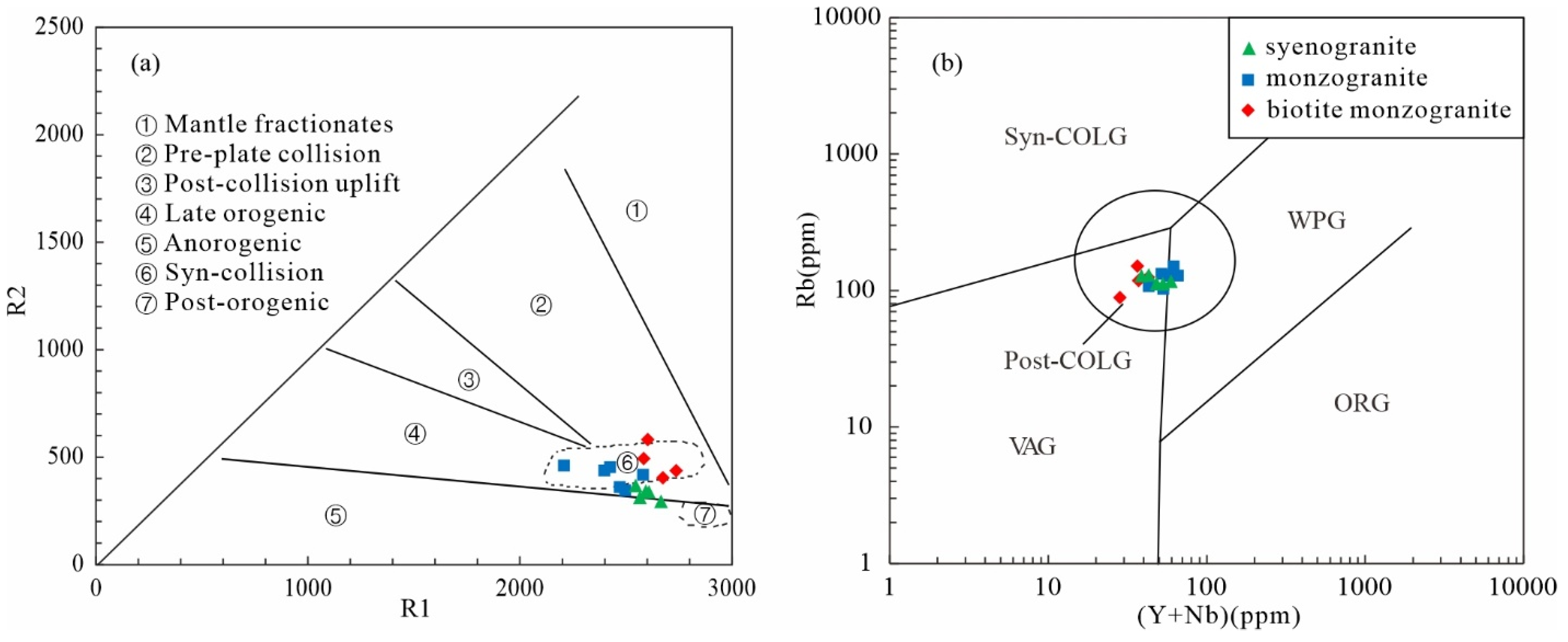Zircon U-Pb Geochronology and Geochemical Constraints of Tiancang Granites, Southern Beishan Orogenic Belt: Implications for Early Permian Magmatism and Tectonic Evolution
Abstract
1. Introduction
2. Geological Background
3. Sample Description and Petrography
4. Analytical Methods and Results
4.1. Zircon U-Pb Geochronology Results
4.2. Whole-Rock Major- and Trace-Element Results
4.3. In Situ Zircon Hf Isotope Results
5. Discussion
5.1. Emplacement Age of Magmatism
5.2. Petrogenesis and Nature of Magma Source
5.3. Tectonic Setting of Early Permian
5.4. Paleozoic Tectonic Evolution of Southern Beishan Orogenic Belt
5.4.1. Subduction–Collision Processes
5.4.2. Post-Collisional Extension
5.4.3. Intracontinental Stable Stage
5.4.4. Intracontinental Rift Stage
6. Conclusions
- (1)
- The emplacement ages of the Tiancang granites (279.3–274.1 Ma) constrain a significant Early Permian magmatic event in the region. These granites exhibit distinct spatiotemporal correlations within the Beishan Orogenic Belt, collectively demonstrating that the Early Permian represents a pivotal tectono-magmatic phase not only in the Beishan Orogenic Belt but also along the southern margin of the Central Asian Orogenic Belt.
- (2)
- Geochemical characteristics reveal that the Early Permian granites in the study area are predominantly high-K calc-alkaline to calc-alkaline, metaluminous to weakly peraluminous I-type granites. Their petrogenesis involved mantle-derived magma-triggered anatexis of ancient crustal materials, accompanied by subsequent magma hybridization and extensive fractional crystallization processes.
- (3)
- The integrated analysis of coeval granite–basalt associations, widespread diabase dykes, rift-related sedimentary sequences, and crust–mantle interaction signatures unequivocally demonstrates Early Permian continental rifting in the study area. These proxies collectively record bimodal magmatism, crustal extension, basin evolution, and significant crust–mantle interactions, providing conclusive evidence for extensional tectonics during this pivotal phase.
Supplementary Materials
Author Contributions
Funding
Data Availability Statement
Acknowledgments
Conflicts of Interest
References
- Windley, B.F.; Alexeiev, D.; Xiao, W.; Kröner, A.; Badarch, G. Tectonic models for accretion of the Central Asian Orogenic Belt. J. Geo. Soc. Lond. 2007, 164, 31–47. [Google Scholar] [CrossRef]
- Xiao, W.J.; Han, C.M.; Yuan, C.; Sun, M.; Lin, S.F.; Chen, H.L.; Li, Z.L.; Li, J.L.; Sun, S. Middle Cambrian to Permian subduction-related accretionary orogenesis of Northern Xinjiang, NW China: Implications for the tectonic evolution of central Asia. J. Asian Earth Sci. 2008, 32, 102–117. [Google Scholar] [CrossRef]
- Xiao, W.J.; Windley, B.F.; Sun, S.; Li, J.; Huang, B.; Han, C.; Yuan, C.; Sun, M.; Chen, H. A tale of amalgamation of three Permo-Triassic collage systems in Central Asia: Oroclines, sutures, and terminal accretion. Annu. Rev. Earth Planet. Sci. 2015, 43, 477–507. [Google Scholar] [CrossRef]
- Şengör, A.M.C.; Sunal, G.; Natal’in, B.A. The Altaids: A review of twenty-five years of knowledge accumulation. Earth-Sci. Rev. 2022, 228, 104013. [Google Scholar] [CrossRef]
- Zha, X.F.; Huang, B.T.; Luo, K.Y.; Sun, J.M.; Guan, C.; Wand, X. Identification of the Permian arc-related magmatic rocks and its significance in Panjiajingzi area, southern margin of Beishan Orogenic Belt. Northwest Geol. 2024, 57, 58–77, (In Chinese with English abstract). [Google Scholar]
- Niu, W.C.; Xin, H.T.; Duan, L.F. The identification and subduction polarity of the Baiheshan ophiolite mélanges belt in the Beishan area, Inner Mongolia: New understanding based on the geological map of Qinghegou Sheet (1:50,000). Geogr. China 2019, 46, 977–994, (In Chinese with English abstract). [Google Scholar]
- Yuan, Y. The continental crust formation and evolution of the Beishan Orogenic Belt. Ph.D. Thesis, China University of Geosciences, Wuhan, China, 2019; pp. 1–144, (In Chinese with English abstract). [Google Scholar]
- Wang, B.R.; Yang, X.S.; Li, S.C.; Teng, C.; Yang, X.J.; Huang, F.Y.; Zhang, X.F.; Cao, J.; Zhou, Y.; Zhang, H.C.; et al. Geochronology, geochemistry, and tectonic implications of early Neoproterozoic granitic rocks from the eastern Beishan Orogenic Belt, southern Central Asian Orogenic Belt. Precambrian Res. 2021, 352, 106016. [Google Scholar] [CrossRef]
- Zhao, G.C.; Wang, Y.; Huang, B.; Dong, Y.; Li, S.; Zhang, G.; Yu, S. Geological reconstructions of the East Asian blocks: From the breakup of Rodinia to the assembly of Pangea. Earth-Sci. Rev. 2018, 186, 262–286. [Google Scholar] [CrossRef]
- Li, Y.B.; Li, H.Q.; Zhou, W.X.; Wang, B.; Chang, F.; Li, S.C.; Yang, X.J. Neoproterozoic thermal events and tectonic implications in the Beishan orogenic belt: Geochemical and geochronological evidence from two sets of granitic rocks from southern Beishan orogenic belt, Gansu Province. Geol. Bull. China 2021, 40, 1117–1139, (In Chinese with English abstract). [Google Scholar]
- Bu, T.; Wang, G.Q.; Huang, B.T.; Dong, Z.C.; Guo, L. Neoproterozoic A-type granites in nortnern Beishan Orogenic Belt: Early response of the Rodinia supercontinent break-up. Acta Petrol. Sin. 2022, 38, 2988–3002, (In Chinese with English abstract). [Google Scholar]
- Santos, G.S.; Hong, T.; Van Staal, C.R.; Bedard, J.; Lin, S.; Wang, K. Permian back-arc basin formation and arc migration in the southern Central Asian Oro genic Belt, Northwest China. Geol. J. 2022, 58, 523–533. [Google Scholar] [CrossRef]
- Dong, Y.P.; Zhou, D.W.; Zhang, G.W. Tectonic setting of the Wuwamen ophiolite at the southern margin of middle Tianshan Belt. Acta Petrol. Sin. 2005, 21, 37–44, (In Chinese with English abstract). [Google Scholar]
- Li, Z.P.; Wu, L.; Yan, L.L. Spatial and temporal distribution of ophiolites and regional tectonic evolution in Northwest China. Geol. Bull. China 2020, 39, 783–871, (In Chinese with English abstract). [Google Scholar]
- Saktura, W.M.; Buckman, S.; Nutman, A.P.; Belousova, E.A.; Yan, Z.; Aitchison, J.C. Continental origin of the Gubaoquan eclogite and implications for evolution of the Beishan Orogen, Central Asian Orogenic Belt, NW China. Lithos 2017, 294, 20–38. [Google Scholar] [CrossRef]
- He, Z.Y.; Zhang, Z.M.; Zong, K.Q.; Xiang, H.; Klemd, R. Metamorphic P-T-t evolution of mafic HP granulites in the northeastern segment of the Tarim Craton (Dunhuang block): Evidence for early Paleozoic continental subduction. Lithos 2014, 196, 1–13. [Google Scholar] [CrossRef]
- Jiang, H.Y.; He, Z.Y. Petrogenesis and tectonic implications of Late Paleozoic granite-diorite from the southern Beishan Orogen. Earth Sci. 2022, 47, 3270–3284, (In Chinese with English abstract). [Google Scholar]
- Xiao, W.J.; Mao, Q.G.; Windley, B.F.; Han, C.M.; Qu, J.F.; Zhang, J.E.; Ao, S.J.; Guo, Q.Q.; Cleven, N.R.; Lin, S.F.; et al. Paleozoic multiple accretionary and collisional processes of the Beishan orogenic collage. Am. J. Sci. 2010, 310, 1553–1594. [Google Scholar] [CrossRef]
- He, Z.Y.; Klemd, R.; Yan, L.L.; Zhang, Z.M. The origin and crustal evolution of microcontinents in the Beishan orogen of the southern Central Asian Orogenic Belt. Earth-Sci. Rev. 2018, 185, 1–14. [Google Scholar] [CrossRef]
- Niu, Y.Z.; Shi, G.R.; Wang, J.Q.; Liu, C.Y.; Zhou, J.L.; Lu, J.C.; Song, B.; Xu, W. The closing of the southern branch of the Paleo-Asian Ocean: Constraints from sedimentary records in the southern Beishan region of the Central Asian Oro genic Belt, NW China. Mar. Petrol. Geol. 2021, 124, 104791. [Google Scholar] [CrossRef]
- Wang, K.; Xiao, W.J.; Windley, B.F.; Mao, Q.G.; Ji, W.H.; Sang, M.; Huang, P.; Wang, P. The Dashui subduction complex in the Eastern Tianshan Beishan Orogen (NW China): Long-Lasting subduction accretion terminated by unique Mid Triassic strike-slip juxtaposition of arcs in the Southern Altaids. Tectonics 2022, 41, e2021TC007190. [Google Scholar] [CrossRef]
- Li, J.; Wu, C.; Chen, X.H.; Zuza, A.; Haoroff, P.; Yin, A.; Shao, Z. Tectonic evolution of the Beishan orogen in central Asia: Subduction, accretion, and continent-continent collision during the closure of the Paleo-Asian Ocean. Geol. Soc. Am. Bull. 2023, 135, 819–851. [Google Scholar] [CrossRef]
- Sun, H.R.; Lü, Z.C.; Yu, X.F.; Li, Y.S.; Du, Z.Z.; Lü, X.; Du, Y.L.; Gong, F.Y. Early Mesozoic tectonic evolution of Beishan Orogenic Belt: Constraints from chronology and geochemistry of the Late Triassic diabase dyke in Liuyuan area, Gansu Province. Acta Petrol. Sin. 2020, 36, 1755–1768, (In Chinese with English abstract). [Google Scholar]
- Niu, Y.Z.; Liu, C.Y.; Shi, G.R.; Lu, J.C.; Xu, W.; Shi, J.Z. Unconformity-bounded Upper Paleozoic mega sequences in the Beishan Region (NW China) and implications for the timing of the Paleo-Asian Ocean closure. J. Asian Earth Sci. 2018, 167, 11–32. [Google Scholar] [CrossRef]
- He, Z.Y.; Sun, L.X.; Mao, L.J.; Zong, K.Q.; Zhang, Z.M. Zircon U–Pb and Hf isotopic study of gneiss and granodiorite from the southern Beishan orogenic collage: Mesoproterozoic magmatism and crustal growth. Chin. Sci. Bull. 2015, 60, 389–399, (In Chinese with English abstract). [Google Scholar]
- Yuan, Y.; Zong, K.Q.; He, Z.Y.; Klemd, R.; Jiang, H.; Zhang, W.; Liu, Y.S.; Hu, Z.C.; Zhang, Z.M. Paleozoic crustal growth and tectonic evolution of the Northern Beishan Orogen, southern Central Asia Orogenic Belt. Lithos 2018, 302–303, 189–202. [Google Scholar] [CrossRef]
- Su, B.X.; Qin, K.Z.; Sakyi, P.A.; Liu, P.P.; Tang, D.M.; Malaviarachchi, S.P.; Xiao, Q.H.; Sun, H.; Dai, Y.C.; Yan, H. Geochemistry and geochronology of acidic rocks in the Beishan region, NW China: Petrogenesis and tectonic implications. J. Asian Earth Sci. 2011, 41, 31–43. [Google Scholar] [CrossRef]
- Li, S.; Wang, T.; Tong, Y.; Wang, Y.B.; Hong, D.W.; Ouyang, Z.X. Zircon U–Pb age, origin and its tectonic significances of Huitongshan Devonian K-feldspar granites from Beishan orogen, NW China. Acta Petrol. Sin. 2011, 27, 3055–3070, (In Chinese with English abstract). [Google Scholar]
- Li, S.; Wang, T.; Wilde, S.A.; Tong, Y.; Hong, D.W.; Guo, Q.Q. Geochronology, petrogenesis and tectonic implications of Triassic granitoids from Beishan, NW China. Lithos 2012, 134–135, 123–145. [Google Scholar] [CrossRef]
- Li, S.; Wilde, S.A.; Wang, T. Early Permian post-collisional high-K granitoids from Liuyuan area in southern Beishan orogen, NW China: Petrogenesis and tectonic implications. Lithos 2013, 179, 99–119. [Google Scholar] [CrossRef]
- Feng, J.C.; Zhang, W.; Wu, T.R.; Zheng, R.G.; Luo, H.L.; He, Y.K. Geochronology and geochemistry of granite pluton in the north of Qiaowan, Beishan Mountain, Gansu province, China, and its geological significance. Acta Sci. Nat. Univ. Pekin. 2012, 48, 61–70, (In Chinese with English abstract). [Google Scholar]
- Song, D.; Xiao, W.; Windley, B.F.; Han, C.; Yang, L. Metamorphic complexes in accretionary orogens: Insights from the Beishan collage, southern Central Asian Orogenic Belt. Tectonophysics 2016, 688, 135–147. [Google Scholar] [CrossRef]
- Zhang, W.; Wu, T.R.; He, Y.K.; Feng, J.C.; Zheng, R.G. LA-ICP-MS zircon U–Pb ages of Xijianquanzi alkali-rich potassium-high granites in Beishan, Gansu Province, and their tectonic significances. Acta Petrol. Mineral. 2010, 29, 719–731, (In Chinese with English abstract). [Google Scholar]
- Zhang, W.; Feng, J.C.; Zheng, R.G.; Wu, T.R.; Luo, H.L.; He, Y.K.; Jing, X. LA-ICPMS zircon U–Pb ages of the granites from the south of Yin’aoxia and their tectonic significances. Acta Petrol. Sin. 2011, 27, 1649–1661, (In Chinese with English abstract). [Google Scholar]
- Zhang, W.; Wu, T.R.; Zheng, R.G.; Feng, J.C.; Luo, H.L.; He, Y.K.; Xu, C. Post-collisional Southeastern Beishan granites: Geochemistry, geochronology, Sr–Nd–Hf isotopes and their implications for tectonic evolution. J. Asian Earth Sci. 2012, 58, 51–63. [Google Scholar] [CrossRef]
- Song, D.F.; Xiao, W.J.; Han, C.M.; Li, J.L.; Qu, J.F.; Guo, Q.Q.; Lin, L.N.; Wang, Z.M. Progressive accretionary tectonics of the Beishan orogenic collage, southern Altaids: Insights from zircon U–Pb and Hf isotopic data of high-grade complexes. Precambrian Res. 2013, 227, 368–388. [Google Scholar] [CrossRef]
- Zheng, R.G.; Wu, T.R.; Xiao, W.; Meng, Q.; Zhang, W. Geochronology, geochemistry and tectonic implications of the Shuangjizi composite pluton in the northern Beishan. Acta Geol. Sin. 2016, 90, 3153–3172, (In Chinese with English abstract). [Google Scholar]
- Xu, W.; Xu, X.Y.; Niu, Y.Z.; Chen, G.C.; Shi, J.Z.; Wei, J.Z.; Wei, J.S.; Song, B.; Zhang, Y.X. Geochronology, petrogenesis and tectonic implications of Early Permian A-type rhyolite from southern Beishan orogen, NW China. Acta Petrol. Sin. 2018, 34, 3011–3033, (In Chinese with English abstract). [Google Scholar]
- Jiang, S.H.; Nie, F.J. Nd-isotope constraints on origin of granitoids in Beishan Mountain area. Acta Geol. Sin. 2006, 80, 826–842, (In Chinese with English abstract). [Google Scholar]
- Zuo, G.C.; Liu, Y.K.; Liu, C.Y. Framework and evolution of the tectonic structure in Beishan area across Gansu Province, Xinjiang Autonomous Region and Inner Mongolia Autonomous Region. Acta Geol. Gansu 2003, 12, 1–15, (In Chinese with English abstract). [Google Scholar]
- Xiao, W.J.; Windley, B.F.; Han, C.M.; Liu, W.; Wan, B.; Zhang, J.E.; Ao, S.J.; Zhang, Z.Y.; Song, D.F. Late Paleozoic to Early Triassic multiple roll-back and oroclinal bending of the Mongolia collage in Central Asia. Earth-Sci. Rev. 2018, 186, 94–128. [Google Scholar] [CrossRef]
- Jiang, H.Y.; He, Z.Y.; Zong, K.Q.; Zhang, Z.M.; Zhao, Z.D. Zircon U–Pb dating and Hf isotopic studies on the Beishan complex in the southern Beishan orogenic belt. Acta Petrol. Sin. 2013, 29, 3949–3967, (In Chinese with English abstract). [Google Scholar]
- Wang, B.R.; Yang, X.S.; Li, S.C.; Teng, C.; Yang, X.J.; Huang, F.Y.; Cao, J.; Yang, B.; Zhang, X.F.; Zhou, Y. Age, depositional environment, and tectonic significance of an Early Neoproterozoic volcano-sedimentary sequence in the eastern Beishan orogenic belt, southern Central Asian Orogenic Belt. Geol. J. 2021, 156, 1346–1357. [Google Scholar] [CrossRef]
- Yuan, Y.; Zong, K.Q.; He, Z.Y.; Klemd, R.; Liu, Y.S.; Hu, Z.C.; Guo, J.L.; Zhang, Z.M. Geochemical and geochronological evidence for a former early Neoproterozoic microcontinent in the South Beishan Orogenic Belt, southernmost Central Asian Orogenic Belt. Precambrian Res. 2015, 266, 409–424. [Google Scholar] [CrossRef]
- Yuan, Y.; Zong, K.Q.; Cawood, P.A.; Cheng, H.; Yu, Y.Y.; Guo, J.L.; Liu, Y.S.; Hu, Z.C.; Zhang, W.; Li, M. Implication of Mesoproterozoic (∼1.4 Ga) Magmatism within microcontinents along the southern Central Asian Orogenic Belt. Precambrian Res. 2019, 327, 314–326. [Google Scholar] [CrossRef]
- Zheng, R.G.; Xiao, W.J.; Li, J.Y.; Wu, T.R.; Zhang, W. A Silurian-early Devonian slab window in the southern Central Asian Orogenic Belt: Evidence from high-Mg diorites, adakites and granitoids in the western Central Beishan region, NW China. J. Asian Earth Sci. 2018, 153, 75–99. [Google Scholar] [CrossRef]
- Zheng, R.C.; Li, J.Y.; Zhang, J.; Xiao, W.J. A prolonged subduction-accretion in the southern Central Asian Orogenic Belt: Insights from anatomy and tectonic affinity for the Beishan complex. Gondwana Res. 2021, 95, 88–112. [Google Scholar] [CrossRef]
- Mao, Q.G.; Xiao, W.J.; Han, C.M.; Sun, M.; Yuan, C.; Zhang, J.; Ao, S.J.; Li, J.L. Discovery of Middle Silurian adakite granite and its tectonic significance in Liuyuan area, Beishan Moutains, NW China. Acta Petrol. Sin. 2010, 26, 584–596, (In Chinese with English abstract). [Google Scholar]
- Mao, Q.G.; Xiao, W.J.; Fang, T.H.; Wang, J.B.; Han, C.M.; Sun, M.; Yuan, C. Late Ordovician to early Devonian adakites and Nbenriched basalts in the Liuyuan area, Beishan, NW China: Implications for early Paleozoic slab-melting and crustal growth in the southern Altaids. Gondwana Res. 2012, 22, 534–553. [Google Scholar] [CrossRef]
- Hong, T.; Santos, G.S.; Staal, C.R.; Ji, W.; Lin, S. Mapping uncovered a multi-phase arc-back-arc system in the southern Beishan during the Permian. Natl. Sci. Rev. 2023, 10, nwac204. [Google Scholar] [CrossRef]
- Xia, L.Q.; Xia, Z.C.; Xu, X.Y.; Li, X.M.; Ma, Z.P. Relative contributions of crust and mantle to the generation of the Tianshan Carboniferous rift-re lated basic lavas, northwestern China. J. Asian Earth Sci. 2008, 31, 357–378. [Google Scholar] [CrossRef]
- Qin, K.Z.; Su, B.S.; Sakyi, P.A.; Tang, D.M.; Li, X.H.; Sun, H.; Xiao, Q.H.; Liu, P.P. SIMS Zircon U-Pb geochrono logy and Sr-Nd isotopes of Ni-Cu bearing mafic-ultramafic in trusions in Eastern Tianshan and Beishan in correlation with flood basalts in Tarim Basin (NW China): Constraints on a ca. 280 Ma mantle plume. Am. J. Sci. 2011, 311, 237–260. [Google Scholar] [CrossRef]
- Zhang, Y.Y.; Dostal, J.; Zhao, Z.H.; Liu, C.; Zuo, G.C. Geochronology, geochemistry and petrogenesis of mafic and ultramafic rocks from Southern Beishan area, NW China: Implications for crust-mantle interaction. Gondwana Res. 2011, 20, 816–830. [Google Scholar] [CrossRef]
- Zhang, Q.W.L.; Chen, Y.C.; Li, Z.M.G.; Liu, J.H.; Zhang, Q.; Wu, C.M. Identification of continent al fragments in orogen: An example from Dunhuang Orogenic Belt, NW China. Sci. Bull. 2022, 67, 1549–1552. [Google Scholar] [CrossRef] [PubMed]
- Wang, G.Q.; Li, X.M.; Xu, X.Y.; Yu, J.Y.; Wu, P.; Ji, B. Research status and progress of Paleozoic ophiolites in Beishan orogenic belt. Geol. Bull. China 2021, 40, 71–81, (In Chinese with English abstract). [Google Scholar]
- Black, L.P.; Kamo, S.L.; Allen, C.M.; Aleinikoff, J.N.; Davis, D.W.; Korsch, R.J.; Foudoulis, C. Temora 1: A new zircon standard for Phanerozoic U-Pb geochronology. Chem. Geol. 2003, 200, 155–170. [Google Scholar] [CrossRef]
- Andersen, T. Correction of common lead in U-Pb analyses that do not report 204Pb. Chem. Geol. 2002, 192, 59–79. [Google Scholar] [CrossRef]
- Yuan, H.L.; Wu, F.Y.; Gao, S.; Liu, X.M.; Xu, P.; Sun, D.Y. Determination of U-Pb age and rare earth element concentrations of zircons from Cenozoic intrusions in northeastern China by laser ablation ICP-MS. Chin. Sci. Bull. 2003, 48, 2411–2421, (In Chinese with English abstract). [Google Scholar] [CrossRef]
- Ludwig, K.R. ISOPLOT 3.0: A Geochronological Toolkit for Microsoft Excel. Berkeley Geochronol. Cent. Spec. Publ. 2003, 4, 1–70. [Google Scholar]
- Xu, P.; Wu, F.Y.; Xie, L.W.; Yang, Y.H. Hf isotopic compositions of the standard zircons for U-Pb dating. Chin. Sci. Bull. 2004, 49, 1642–1648, (In Chinese with English abstract). [Google Scholar] [CrossRef]
- Soderlund, U.; Patchett, P.J.; Vervoort, J.D.; Isachsen, C.E. The 176Lu decay constant determined by Lu–Hf and U–Pb isotope systematics of Precambrian mafic intrusions. Earth Planet. Sci. Lett. 2004, 219, 311–324. [Google Scholar]
- Blichert-Toft, J.; Albarede, F. The Lu-Hf isotope geochemistry of chondrites and the evolution of the mantle-crust system. Earth Planet. Sci. Lett. 1997, 148, 243–258. [Google Scholar] [CrossRef]
- Griffin, W.L.; Pearson, N.J.; Belousova, E.; Jackson, S.E.; van Achterbergh, E.; O’Reilly, S.Y.; Shee, S.R. The Hf isotope composition of cratonic mantle: LAM-MC-ICPMS analysis of zircon megacrysts in kimberlites. Geochim. Cosmochim. Acta 2000, 64, 133–147. [Google Scholar] [CrossRef]
- Hoskin, P.W.; Schaltegger, U. The composition of zircon and igneous and metamorphic petrogenesis. Rev. Mineral. Geochem. 2003, 53, 27–62. [Google Scholar] [CrossRef]
- Peccerillo, A.; Taylor, S.R. Geochemistry of eocene calc-alkaline volcanic rocks from the Kastamonu area, Northern Turkey. Contrib. Mineral. Petrol. 1976, 58, 63–81. [Google Scholar] [CrossRef]
- Maniar, P.D.; Piccoli, P.M. Tectonic discrimination of granitoids. GSA Bull. 1989, 101, 635–643. [Google Scholar] [CrossRef]
- Frost, B.R.; Barnes, C.G.; Collins, W.J.; Arculus, R.J.; Ellis, D.J.; Frost, C.D. A geochemical classification for granitic rocks. J. Petrol. 2001, 42, 2033–2048. [Google Scholar] [CrossRef]
- Frost, B.R.; Frost, C.D. A geochemical classification for feldspathic igneous rocks. J. Petrol. 2008, 49, 1955–1969. [Google Scholar] [CrossRef]
- Sun, S.S.; McDonough, W.F. Chemical and isotopic systematics of oceanic basalts: Implications for mantle composition and processes. Geol. Soc. Lond. Special. Publ. 1989, 42, 313–345. [Google Scholar] [CrossRef]
- China Geological Survey. The Waizuishan, Shahongshan, Qingshanpo, Diwandongliang, Tiancang 1:50,000 Regional Geological Survey Report; China Geological Survey: Beijing, China, 2019; pp. 1–243.
- Niu, Y.Z.; Lu, J.C.; Liu, C.Y.; Xu, W.; Shi, J.Z.; Song, B. Geochronology and distribution of the Upper Carboniferous–Lower Permian Ganquan formation in the Beishan region, Northwestern China and its tectonic implication. Geol. Rev. 2018, 64, 806–827. [Google Scholar]
- Niu, Y.Z.; Lu, J.C.; Liu, C.Y.; Song, B.; Shi, J.Z.; Xu, W. Chronostratigraphy and regional comparison of marine Permian system in the Beishan region, North China. Acta Geol. Sin. 2018, 92, 1131–1148, (In Chinese with English abstract). [Google Scholar]
- Su, B.X.; Qin, K.Z.; Sun, H.; Tang, D.M.; Sakyi, P.A.; Chu, Z.Y.; Liu, P.P.; Xiao, Q.H. Subduction-induced mantle heterogeneity beneath Eastern Tianshan and Beishan: Insights from Nd–Sr–Hf–O isotopic mapping of Late Paleozoic mafic–ultramafic complexes. Lithos 2012, 134–135, 41–51. [Google Scholar] [CrossRef]
- Su, B.X.; Qin, K.Z.; Sakyi, P.A.; Li, X.H.; Yang, Y.H.; Sun, H.; Tang, D.M.; Liu, P.P.; Xiao, Q.H.; Malaviarachchi, S.P.K. U–Pb ages and Hf–O isotopes of zircons from Late Paleozoic mafic–ultramafic units in the southern Central Asian Orogenic Belt: Tectonic implications and evidence for an Early–Permian mantle plume. Gondwana Res. 2011, 20, 516–531. [Google Scholar] [CrossRef]
- Pirajno, F.; Ernst, R.E.; Borisenko, A.S.; Fedoseev, G.; Naumov, E.A. Intraplate magmatism in Central Asia and China and associated metallogeny. Ore Geol. Rev. 2009, 35, 114–136. [Google Scholar] [CrossRef]
- Chen, X.J.; Shu, L.S.; Santosh, M. Late Paleozoic post-collisional magmatism in the Eastern Tianshan Belt, Northwest China: New insights from geochemistry, geochronology and petrology of bimodal volcanic rocks. Lithos 2011, 127, 581–598. [Google Scholar] [CrossRef]
- Gu, L.X.; Zhang, Z.Z.; Wu, C.Z.; Wang, Y.X.; Tang, J.H.; Wang, C.S.; Xi, A.H.; Zheng, Y.C. Some problems on granites and vertical growth of the continental crust in the eastern Tianshan Mountains, NW China. Acta Petrol. Sin. 2006, 22, 1103–1120, (In Chinese with English abstract). [Google Scholar]
- Wolf, M.B.; London, D. Apatite dissolution into peraluminous haplogranitic melts: An experimental study of solubilities and mechanism. Geochim. Et Cosmochim. Acta 1994, 58, 4127–4145. [Google Scholar] [CrossRef]
- Li, X.H.; Li, Z.X.; Li, W.X.; Liu, Y.; Yuan, C.; Wei, J.S.; Qi, C.S. U-Pb zircon, geochemical and Sr-Nd-Hf isotopic constraints on age and origin of Jurassic I- and A-type granites from central Guangdong, SE China: A major igneous event in response to foundering of a subducted flat-slab? Lithos 2007, 96, 186–204. [Google Scholar] [CrossRef]
- Chappell, B.W. Aluminium saturation in I- and S-type granites and the characterization of fractionated haplogranites. Lithos 1999, 46, 535–551. [Google Scholar] [CrossRef]
- Wu, F.Y.; Jahn, B.M.; Wilder, S.A.; Lo, C.H.; Yui, T.F.; Lin, Q.; Ge, W.C.; Sun, D.Y. Highly fractionated I-type granites in NE China (I): Geochronology and petrogenesis. Lithos 2003, 66, 241–273. [Google Scholar] [CrossRef]
- Li, X.H.; Li, Z.X.; Li, W.X.; Wang, Y. Initiation of the Indosinian Orogeny in South China: Evidence for a Permian magmatic arc in the Hainan Island. J. Geol. 2006, 114, 341–353. [Google Scholar] [CrossRef]
- Whalen, J.; Currie, K.; Chappell, B. A-type granites: Geochemical characteristics, discrimination and petrogenesis. Contrib. Miner. Petrol. 1987, 95, 407–419. [Google Scholar] [CrossRef]
- Allègre, C.J.; Ben, O.D. Nd-Sr isotopic relationship in granitoid rocks and continental crust development: A chemical approach to orogenesis. Nature 1980, 286, 335–342. [Google Scholar] [CrossRef]
- Patiño Douce, A.E. What do experiments tell us about the relative contributions of crust and mantle to the origin of granitic magmas? Geol. Soc. Special. Publ. 1999, 168, 55–75. [Google Scholar] [CrossRef]
- Healy, B.; Collins, W.J.; Richards, S.W. A hybrid origin for Lachlan S-type granites: The Murrumbidgee Batholith example. Lithos 2004, 78, 197–216. [Google Scholar] [CrossRef]
- Zhu, D.C.; Mo, X.X.; Niu, Y.L.; Zhao, Z.D.; Wang, L.Q.; Pan, G.T.; Wu, F.Y. Zircon U-Pb dating and in-situ Hf isotopic analysis of Permian peraluminous granite in the Lhasa Terrane, southern Tibet: Implications for Permian collisional orogeny and paleogeography. Tectonophysics 2009, 469, 48–60. [Google Scholar] [CrossRef]
- Collins, W.J.; Beams, S.D.; White, A.J.R.; Chappell, B.W. Nature and origin of A-type granites with particular reference to southeastern Australia. Contrib. Miner. Petrol. 1982, 80, 189–200. [Google Scholar] [CrossRef]
- Wu, F.Y.; Li, X.C.; Ji, W.Q.; Wang, J.M.; Yang, L. Highly fractionated granites: Recognition and research. Sci. China Earth Sci. 2017, 60, 1201–1219. [Google Scholar] [CrossRef]
- King, P.L.; White, A.J.R.; Chappell, B.W.; Allen, C.M. Characterization and origin of aluminous A-type granites from the Lachlan Fold Belt, southeastern Australia. J. Petrol. 1997, 38, 371–391. [Google Scholar] [CrossRef]
- Watson, E.B.; Harrison, T.M. Zircon saturation revisited: Temperature and compositional effects in variety of crustal magma types. Earth Planet. Sci. Lett. 1983, 64, 295–304. [Google Scholar] [CrossRef]
- Kemp, A.I.S.; Hawkesworth, C.J.; Foster, G.L.; Paterson, B.A.; Woodhead, J.D.; Hergt, J.M.; Gray, C.M.; Whitehouse, M.J. Magmatic and crustal differentiation history of granitic rocks from Hf-O isotopes in zircon. Science 2007, 315, 980–983. [Google Scholar] [CrossRef]
- Bolhar, R.; Weaver, S.D.; Whitehouse, M.J.; Palin, J.M.; Woodhead, J.D.; Cole, J.W. Sources and evolution of arc magmas inferred from coupled O and Hf isotope systematics of plutonic zircons from the Cretaceous Separation Point Suite (New Zealand). Earth Planet. Sci. Lett. 2008, 268, 312–324. [Google Scholar] [CrossRef]
- Griffin, W.L.; Wang, X.; Jackson, S.E.; Pearson, S.E.; O’Reilly, S.Y.; Xu, X.S.; Zhou, X.M. Zircon chemistry and magma mixing, SE China: In-situ analysis of Hf isotopes, Tonglu and Pingtan igneous complexes. Lithos 2002, 61, 237–269. [Google Scholar] [CrossRef]
- Beloisova, B.A.; Griffin, W.L.; O’Reilly, S.Y. Zircon crystal morphology, trace element signatures and Hf isotope composition as a tool for petrogenetic modeling: Examples from Eastern Australian granitoids. J. Petrol. 2006, 47, 329–353. [Google Scholar] [CrossRef]
- Yang, J.H.; Wu, F.Y.; Wilde, S.A.; Xie, L.W.; Yang, Y.H.; Liu, X.M. Tracing magma mixing in granite genesis: In situ U-Pb dating and Hf-isotope analysis of zircons. Contrib. Miner. Petrol. 2007, 153, 177–190. [Google Scholar] [CrossRef]
- Wang, Y.; Luo, Z.H.; Santosh, M.; Wang, S.Z.; Wang, N. The Liuyuan Volcanic Belt in NW China Revisited:Evidence for Permian Rifting Associated with the Assembly of Continental Blocks in the Central Asian Orogenic Belt. Geol. Mag. 2017, 154, 265–285. [Google Scholar] [CrossRef]
- Xu, W.; Xu, X.Y.; Niu, Y.Z.; Song, B.; Chen, G.C.; Shi, J.Z.; Zhang, Y.X.; Li, C.H. Geochronology and Petrogenesis of the Permian Marine Basalt in the Southern Beishan Region and Their Tectonic Implications. Acta Geol. Sin. 2019, 93, 1928–1953, (In Chinese with English abstract). [Google Scholar]
- Wu, F.Y.; Sun, D.Y.; Li, H.M.; Jahn, B.M.; Wilde, S. A-type granites in northeastern China: Age and geochemical constraints on their petrogenesis. Chem. Geol. 2002, 187, 143–173. [Google Scholar] [CrossRef]
- Chen, B.; Jahn, B.M. Genesis of post-collisional granitoids and basement nature of the Junggar Terrane, NW China: Nd–Sr isotope and trace element evidence. J. Asian Earth Sci. 2004, 23, 691–703. [Google Scholar] [CrossRef]
- Seltmann, R.; Konopelko, D.; Biske, G.; Divaev, F.; Sergeev, S. Hercynian postcollisional magmatism in the context of Paleozoic magmatic evolution of the Tien Shan orogenic belt. J. Asian Earth Sci. 2011, 42, 821–838. [Google Scholar] [CrossRef]
- Yuan, C.; Sun, M.; Xiao, W.J.; Li, X.H.; Chen, H.L.; Lin, S.F.; Xia, X.P.; Long, X.P. Accretionary orogenesis of the Chinese Altai: Insights from the Paleozoic granitoids. Chem. Geol. 2007, 242, 22–39. [Google Scholar] [CrossRef]
- Zuo, G.C.; He, G.Q. Plate Tectonics and Metallogenic Regularities in Beishan Region; Peking University Press: Beijing China, 1990; pp. 1–226. [Google Scholar]
- Zuo, G.C.; Li, M.S. Formation and Evolution of the Early Paleozoic Lithosphere in the Beishan Area, Gansu-Inner Mongolia, China; Lanzhou Science and Technology Press: Lanzhou, China, 1996; pp. 1–120. [Google Scholar]
- Lu, J.C.; Chen, G.C.; Wei, X.Y.; Li, Y.H.; Wei, J.S. Carboniferous-Permian sedimentary formation and hydrocarbon generation conditions in Ejin Banner and its vicinities, western Inner Mongolia: A study of Carboniferous-Permian petroleum geological conditions (part 1). Geol. Bull. China 2011, 30, 811–826, (In Chinese with English abstract). [Google Scholar]
- Batchelor, R.A.; Bowden, P. Petrogenetic interpretation of granitoid rock series using multicationic parameters. Chem. Geol. 1985, 48, 43–55. [Google Scholar] [CrossRef]
- Pearce, J. Source and settings of granitic rocks. Episodes 1996, 19, 120–125. [Google Scholar] [CrossRef]
- Zhang, Y.Y.; Guo, Z.J. Accurate constraint on formation and emplacement age of Hongliuhe ophiolite, boundary region between Xinjiang and Gansu Provinces and its tectonic implications. Acta Petrol. Sin. 2008, 24, 803–809, (In Chinese with English abstract). [Google Scholar]
- Shi, J.Z.; Lu, J.C.; Wei, J.S.; Niu, Y.Z.; Jiang, T.; Han, X.F.; Xu, W. Petrology, geochemistry and sedimentary environment of Permian siliceous rocks in Yinen-Ejin basin and its adjacent areas. Geol. Bull. China 2018, 37, 120–131, (In Chinese with English abstract). [Google Scholar]
- Ao, S.J.; Xiao, W.J.; Han, C.M.; Li, X.H.; Qu, J.F.; Zhang, J.E.; Guo, Q.Q.; Tian, Z.H. Cambrian to early Silurian ophiolite and accretionary processes in the Beishan collage, NW China: Implications for the architecture of the Southern Altaids. Geol. Mag. 2012, 149, 606–625. [Google Scholar] [CrossRef]
- Hou, Q.Y.; Wang, Z.; Liu, J.B.; Wang, J.; Li, D.F. Geochemistry Characteristics and SHRIMP Dating of Yueyashan Ophiolite in Beishan Orogen. Geoscience 2012, 26, 1008–1018. [Google Scholar]
- Zhao, Z.H.; Guo, Z.J.; Wang, Y. Geochronology, geochemical characteristics and tectonic implications of the granitoids from Liuyuan area, Beishan, Gansu province, northwest China. Acta Petrol. Sin. 2007, 23, 1847–1860, (In Chinese with English abstract). [Google Scholar]
- Li, X.F.; Zhang, C.L.; Li, L.; Bao, Z.A.; Zhang, B.L.; Wei, Q. Formation age, geochemical characteristics of the Mingshujing pluton in Beishan area of Gansu Province and its geological significance. Acta Petrol. Sin. 2015, 31, 2521–2538, (In Chinese with English abstract). [Google Scholar]
- Wang, H.J.; Bai, J.K.; Zhao, H.B.; Cheng, L.; Zhu, L.K.; Guo, F. Early Paleozoic Paleo-Asian Ocean subduction in the southern Beishan, Gansu: Evidence of zircon U−Pb age and geochemical records from Mingshujing adakitic pluton. Geol. Bull. China 2024, 43, 376–389, (In Chinese with English abstract). [Google Scholar]
- Liu, X.C.; Chen, B.L.; Jahn, B.M.; Wu, G.G.; Liu, Y.S. Early Paleozoic (ca. 465 Ma) eclogites from Beishan (NW China) and their bearing on the tectonic evolution of the southern Central Asian Orogenic Belt. J. Asian Earth Sci. 2011, 42, 715–731. [Google Scholar] [CrossRef]
- Qu, J.F.; Xiao, W.J.; Windley, B.F.; Han, C.M.; Mao, Q.G.; Ao, S.J.; Zhang, J.E. Metamorphic evolution and P-T trajectory of eclogites from the Chinese Beishan: Implications for the Paleozoic tectonic evolution of the southern Altaids. J. Metamorph. Geol. 2011, 29, 803–820. [Google Scholar] [CrossRef]
- He, S.P.; Zhou, H.W.; Yao, W.G.; Ren, B.C.; Fu, L.P. Discovery and significance of Radiolaria from Middle Devonian conglomerate in Beishan area, Gansu. Northwest. Geol. 2004, 37, 24–28, (In Chinese with English abstract). [Google Scholar]
- Liu, M.Q.; Dang, Y.Y.; Gong, Q.S. The feature of Pingtoushan thrust-nappe structure in Beishan, Gansu. Northwest Geol. 2002, 35, 22–27, (In Chinese with English abstract). [Google Scholar]
- Lü, X.; Yu, X.F.; Du, Z.Z.; Kang, K.; Du, Y.L.; Wang, C.N. Late Devonian magmatic event in the South Beishan orogenic belt, Gansu: Constraints from zircon U-Pb chronology, geochemistry and Sr-Nd-Hf isotopes. Acta Petrol. Sin. 2022, 38, 693–712, (In Chinese with English abstract). [Google Scholar]
- Ao, S.J.; Xiao, W.J.; Han, C.M.; Mao, Q.G.; Zhang, J.E. Geochronology and geochemistry of Early Permian mafic-ultramafic complexes in the Beishan area, Xinjiang, NW China: Implications for late Paleozoic tectonic evolution of the southern Altaids. Gondwana Res. 2010, 18, 466–478. [Google Scholar] [CrossRef]
- Wang, H.Y.C.; Chen, H.X.; Lu, J.S.; Wang, G.D.; Peng, T.; Zhang, H.C.; Yan, Q.R.; Hou, Q.L.; Zhang, Q.; Wu, C.M. Metamorphic evolution and SIMS U-Pb geochronology of the Qingshigou area, Dunhuang block, NW China: Tectonic implications of the southernmost Central Asian orogenic belt. Lithosphere 2016, 8, 463–479. [Google Scholar] [CrossRef]
- Wang, H.Y.C.; Chen, H.X.; Zhang, Q.W.; Shi, M.Y.; Yan, Q.R.; Hou, Q.L.; Zhang, Q.; Kusky, T.; Wu, C.M. Tectonic mélange records the Silurian-Devonian subduction-metamorphic process of the southern Dunhuang terrane, southernmost Central Asian Orogenic Belt. Geology 2017, 45, 427–430. [Google Scholar] [CrossRef]
- Xie, W.; Song, X.Y.; Deng, Y.F.; Wang, Y.S.; Ba, D.H.; Zheng, W.Q.; Li, X.B. Geochemistry and petrogenetic implications of a Late Devonian mafic-ultramafic intrusion at the southern margin of the Central Asian Orogenic Belt. Lithos 2012, 144–145, 209–230. [Google Scholar] [CrossRef]
- Xue, S.C.; Li, C.; Qin, K.Z.; Tang, D.M. A non-plume model for the Permian protracted (266-286 Ma) basaltic magmatism in the Beishan-Tianshan region, Xinjiang, Western China. Lithos 2016, 256–257, 243–249. [Google Scholar] [CrossRef]
- Xue, S.; Qin, K.; Li, C.; Tang, D.; Mao, Y.; Qi, L.; Ripley, E.M. Geochronological, petrological, and geochemical constraints on Ni-Cu sulfide mineralization in the Poyi ultramafic-troctolitic intrusion in the northeast rim of the Tarim craton, western China. Econ. Geol. 2016, 111, 1465–1484. [Google Scholar] [CrossRef]
- Xue, S.; Qin, K.; Li, C.; Tang, D.; Wang, Q.; Wang, X. Permian bimodal magmatism in the southern margin of the Central Asian Orogenic Belt, Beishan, Xinjiang, NW China: Petrogenesis and implication for post-subduction crustal growth. Lithos 2018, 314, 617–629. [Google Scholar] [CrossRef]
- Xue, S.; Qin, K.; Li, C.; Yao, Z.; Ripley, E.M.; Wang, X. Geochronological, mineralogical and geochemical studies of sulfide mineralization in the Podong mafic-ultramafic intrusion in northern Xinjiang, western China. Ore Geol. Rev. 2018, 101, 688–699. [Google Scholar] [CrossRef]
- Yu, J.; Guo, L.; Li, J.; Li, Y.; Smithies, R.H.; Wingate, M.T.D.; Meng, Y.; Chen, S. The petrogenesis of sodic granites in the Niujuanzi area and constraints on the Paleozoic tectonic evolution of the Beishan region, NW China. Lithos 2016, 256–257, 250–268. [Google Scholar] [CrossRef]
- Zhang, W.; Pease, V.; Meng, Q.; Zheng, R.; Thomsen, T.B.; Wohlgemuth-Ueberwasser, C.; Wu, T. Timing, petrogenesis, and setting of granites from the southern Beishan late Palaeozoic granitic belt, Northwest China and implications for their tectonic evolution. Int. Geol. Rev. 2015, 57, 1975–1991. [Google Scholar] [CrossRef]
- Zhang, W.; Pease, V.; Meng, Q.P.; Zheng, R.G.; Thomsen, T.B.; Wohlgemuth-Ueberwasser, C.; Wu, T.R. Discovery of a Neoproterozoic granite in the Northern Alxa region, NW China: Its age, petrogenesis and tectonic significance. Geol. Mag. 2015, 153, 512–523. [Google Scholar] [CrossRef]
- Zheng, R.G.; Wu, T.R.; Zhang, W.; Meng, Q.P.; Zhang, Z.Y. Geochronology and geochemistry of late Paleozoic magmatic rocks in the Yinwaxia area, Beishan: Implications for rift magmatism in the southern Central Asian Orogenic Belt. J. Asian Earth Sci. 2014, 91, 39–55. [Google Scholar] [CrossRef]
- Zhu, J.; Lv, X.; Peng, S. U-Pb zircon geochronology, geochemistry and tectonic implications of the early Devonian granitoids in the Liuyuan area, Beishan, NW China. Geosci. J. 2016, 20, 609–625. [Google Scholar] [CrossRef]
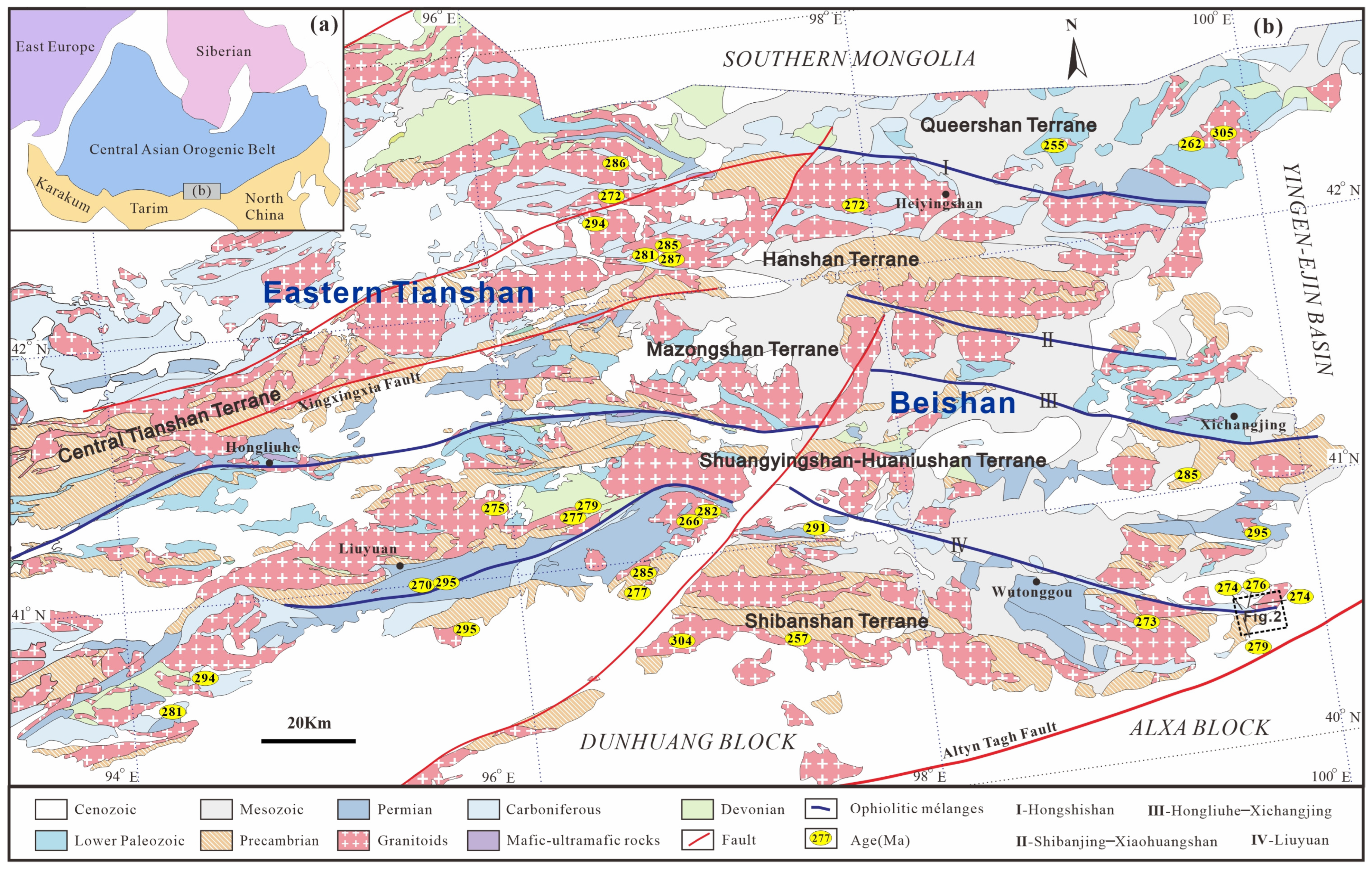
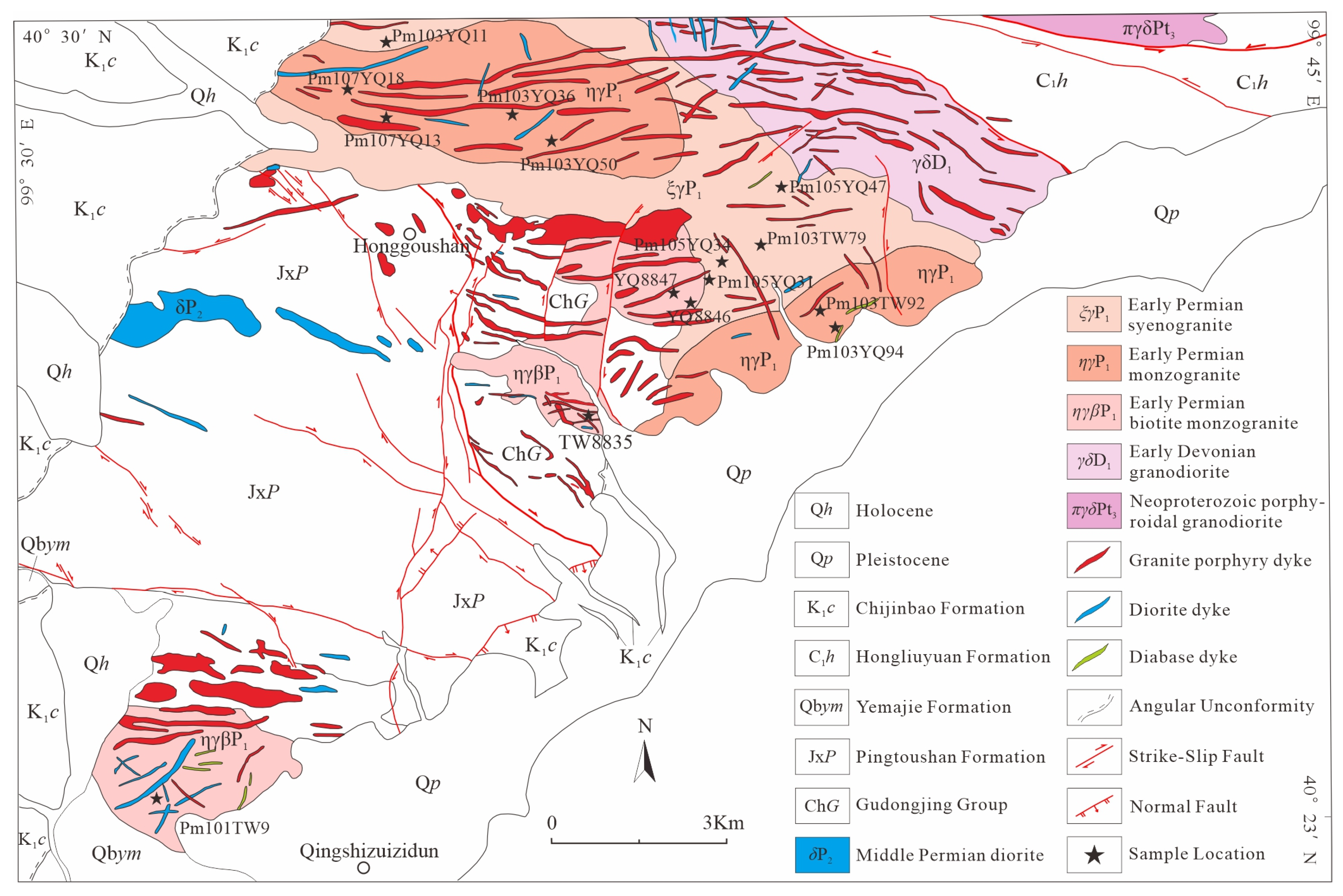
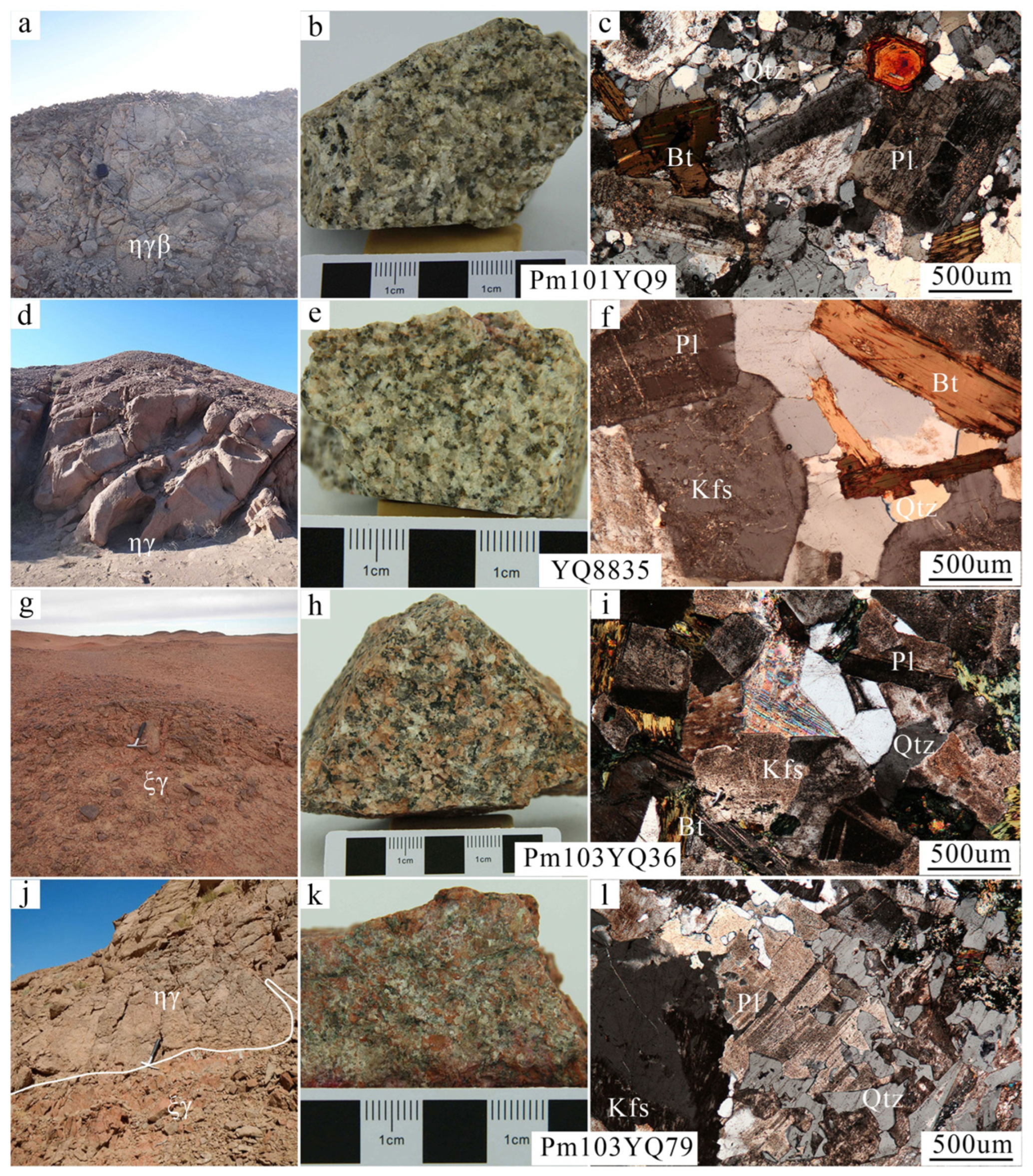

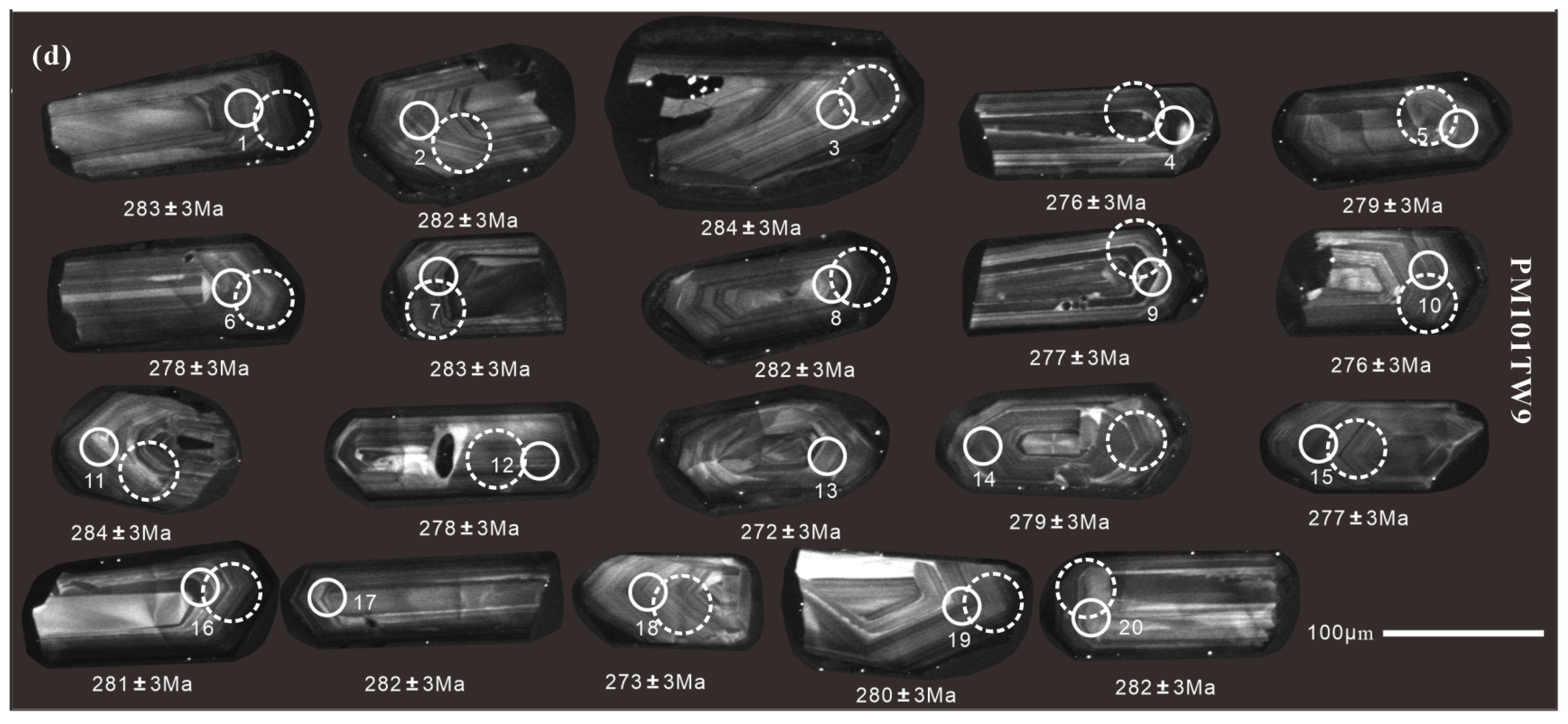
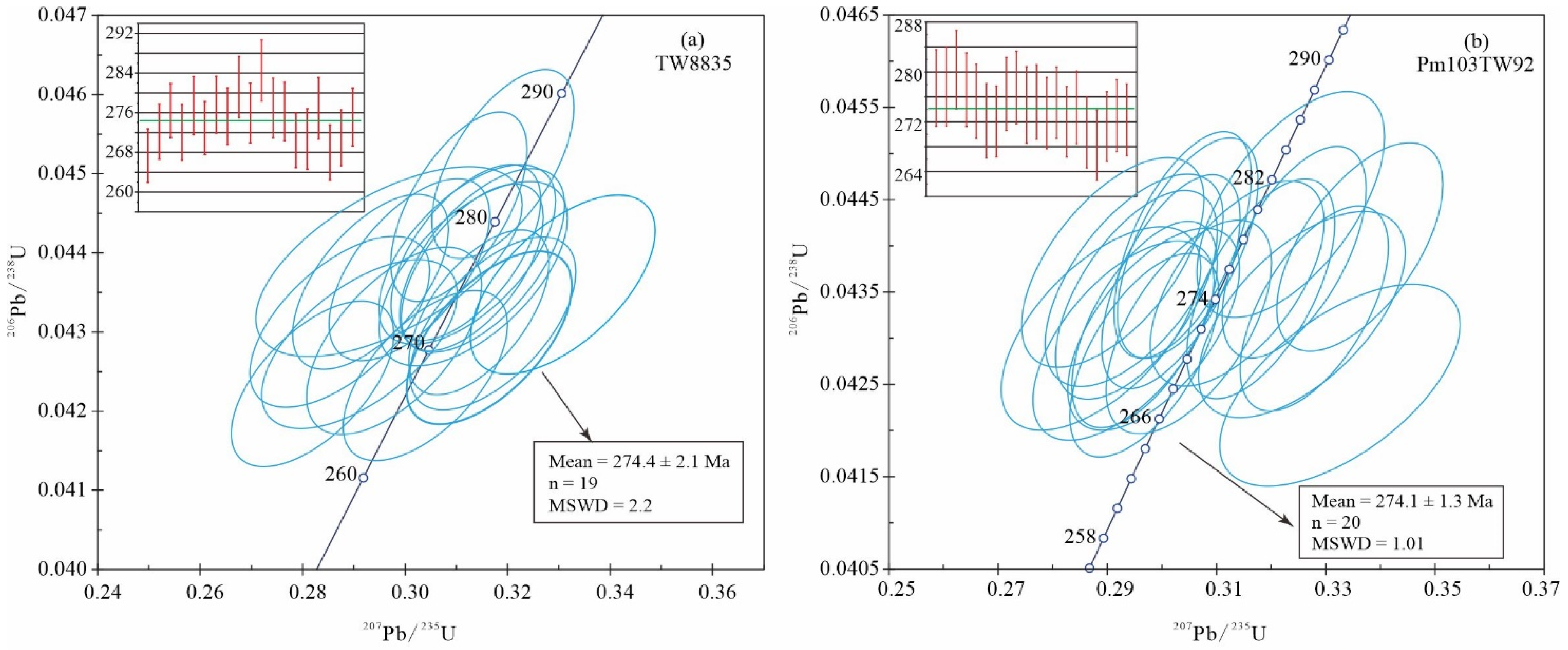
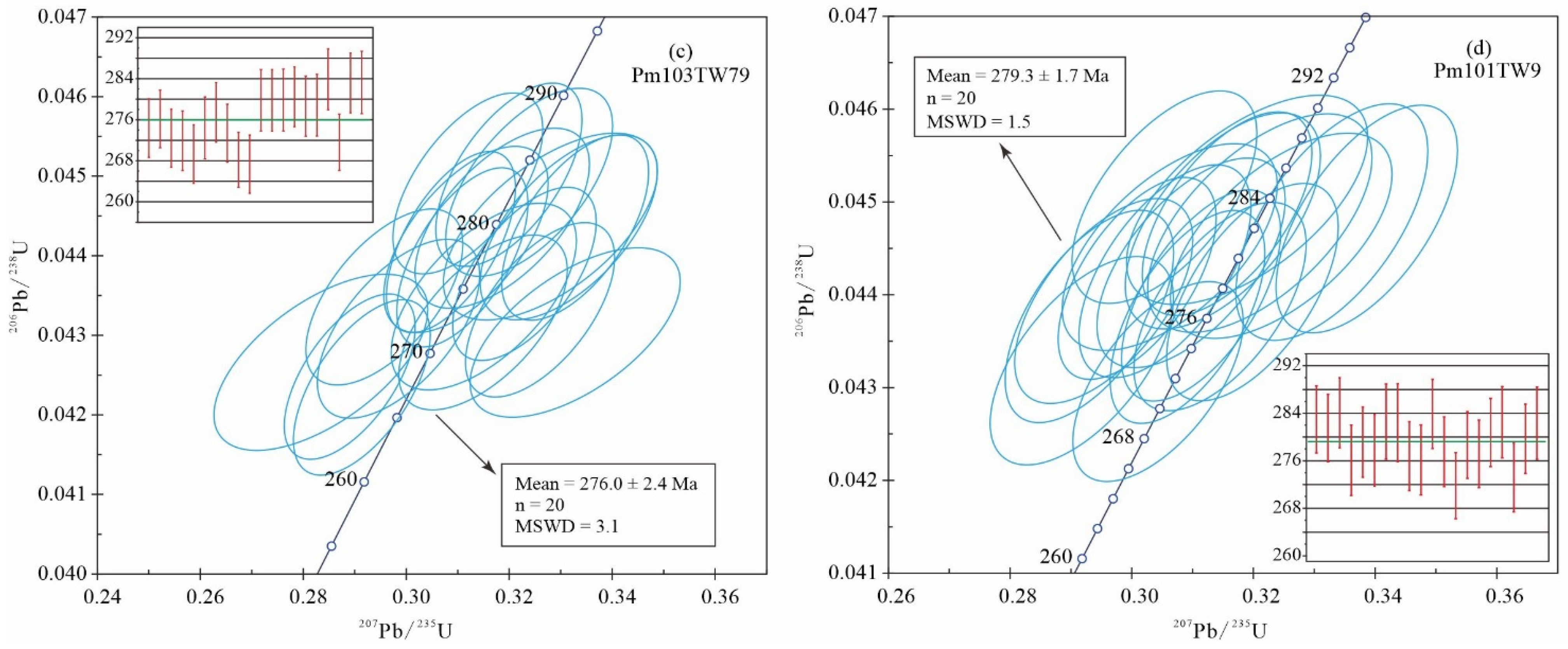


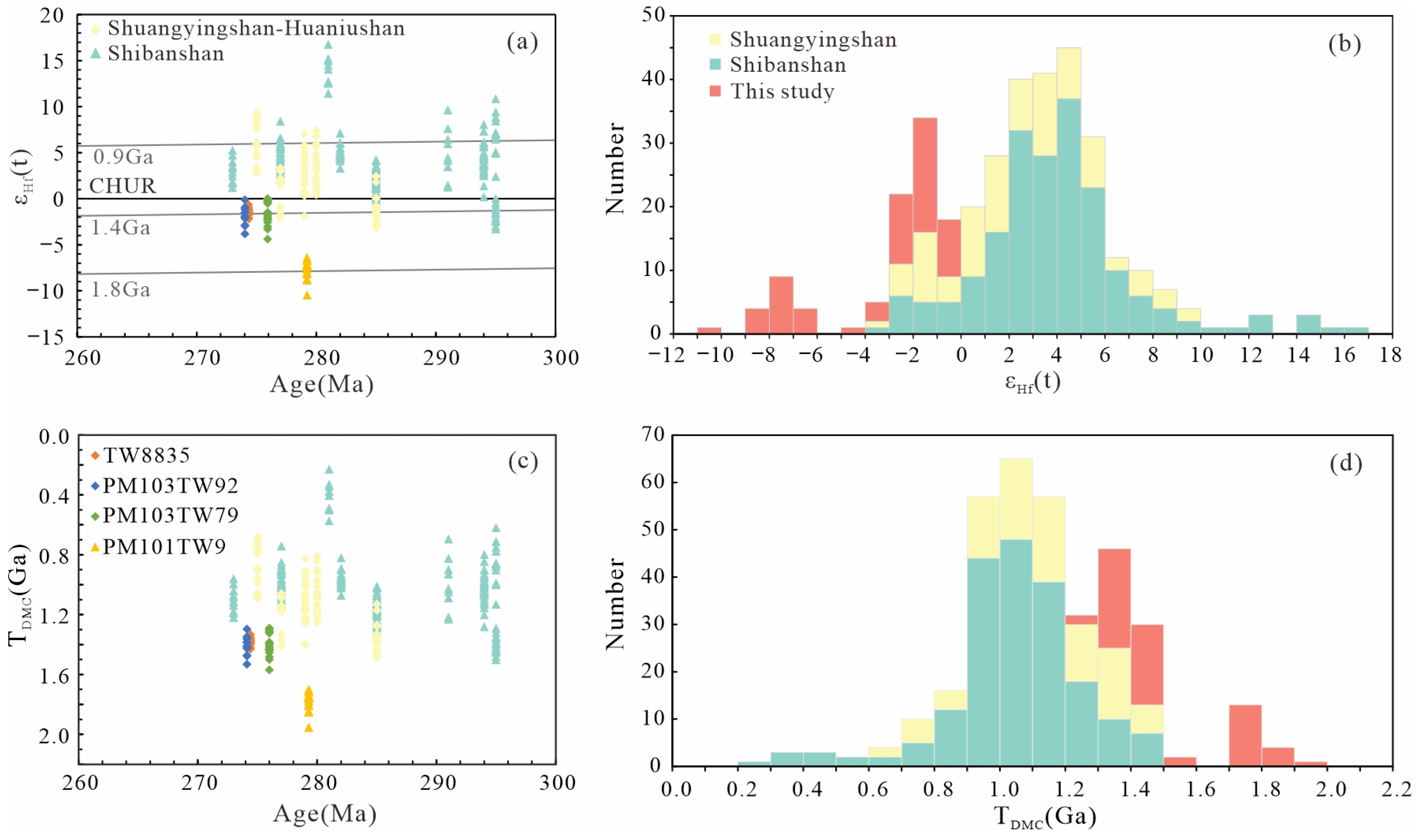
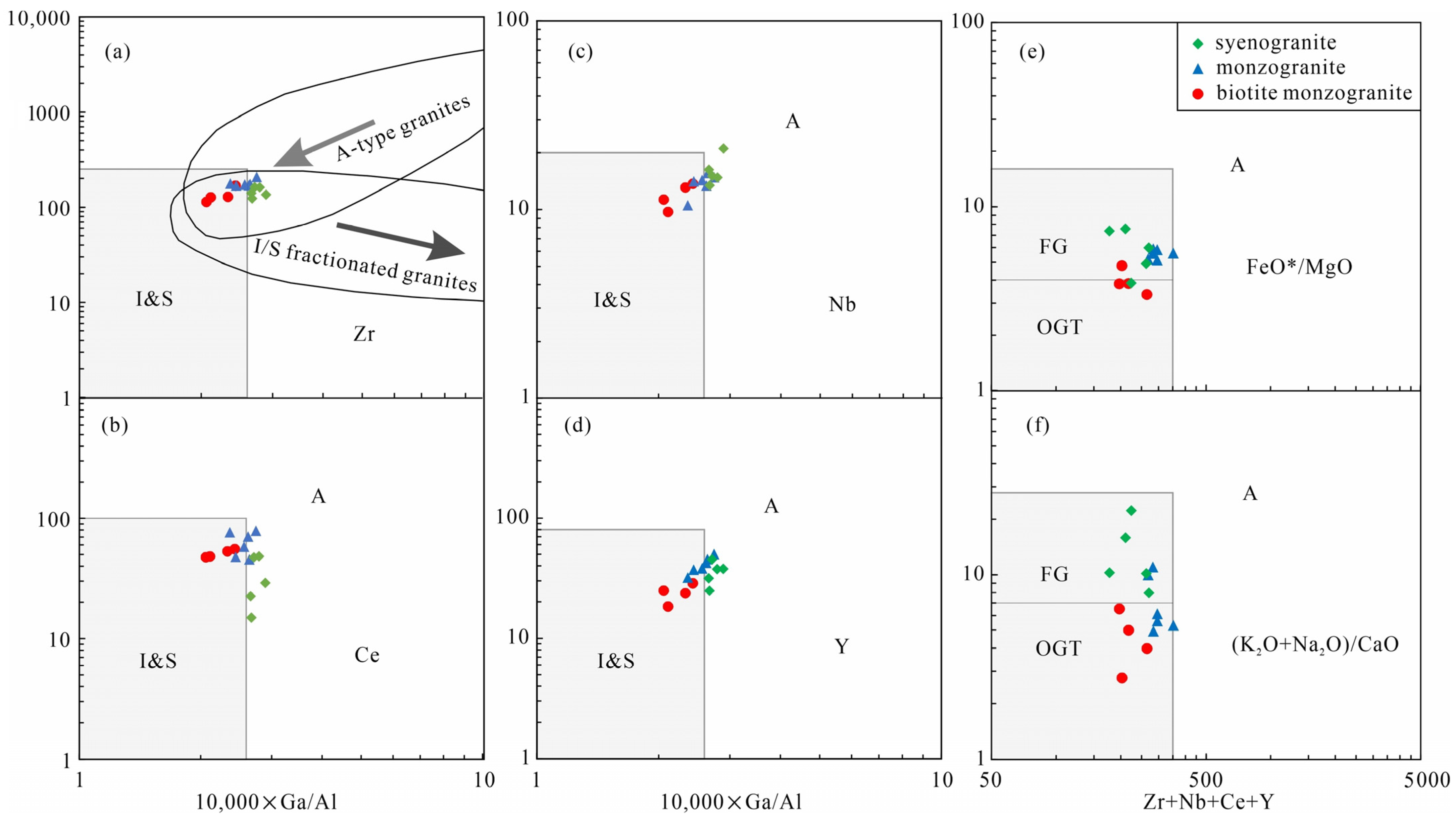
Disclaimer/Publisher’s Note: The statements, opinions and data contained in all publications are solely those of the individual author(s) and contributor(s) and not of MDPI and/or the editor(s). MDPI and/or the editor(s) disclaim responsibility for any injury to people or property resulting from any ideas, methods, instructions or products referred to in the content. |
© 2025 by the authors. Licensee MDPI, Basel, Switzerland. This article is an open access article distributed under the terms and conditions of the Creative Commons Attribution (CC BY) license (https://creativecommons.org/licenses/by/4.0/).
Share and Cite
Teng, C.; Dong, M.; Yang, X.; Xiao, D.; Shao, J.; Cao, J.; Su, Y.; Lu, W. Zircon U-Pb Geochronology and Geochemical Constraints of Tiancang Granites, Southern Beishan Orogenic Belt: Implications for Early Permian Magmatism and Tectonic Evolution. Minerals 2025, 15, 426. https://doi.org/10.3390/min15040426
Teng C, Dong M, Yang X, Xiao D, Shao J, Cao J, Su Y, Lu W. Zircon U-Pb Geochronology and Geochemical Constraints of Tiancang Granites, Southern Beishan Orogenic Belt: Implications for Early Permian Magmatism and Tectonic Evolution. Minerals. 2025; 15(4):426. https://doi.org/10.3390/min15040426
Chicago/Turabian StyleTeng, Chao, Meiling Dong, Xinjie Yang, Deng Xiao, Jie Shao, Jun Cao, Yalatu Su, and Wendong Lu. 2025. "Zircon U-Pb Geochronology and Geochemical Constraints of Tiancang Granites, Southern Beishan Orogenic Belt: Implications for Early Permian Magmatism and Tectonic Evolution" Minerals 15, no. 4: 426. https://doi.org/10.3390/min15040426
APA StyleTeng, C., Dong, M., Yang, X., Xiao, D., Shao, J., Cao, J., Su, Y., & Lu, W. (2025). Zircon U-Pb Geochronology and Geochemical Constraints of Tiancang Granites, Southern Beishan Orogenic Belt: Implications for Early Permian Magmatism and Tectonic Evolution. Minerals, 15(4), 426. https://doi.org/10.3390/min15040426







